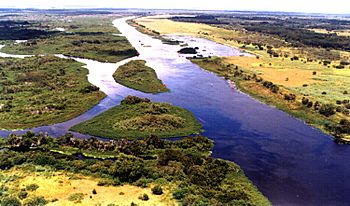Kissimmee River facts for kids
Quick facts for kids Kissimmee River |
|
|---|---|

A stretch of the straightened and channelized Kissimmee River in central Florida
|
|

The Kissimmee River flows down the middle of central Florida into Lake Okeechobee.
|
|
| Country | United States |
| State | Florida |
| Physical characteristics | |
| Main source | East Lake Tohopekaliga Osceola County, Florida 27°59′25″N 81°22′44″W / 27.99028°N 81.37889°W |
| River mouth | Lake Okeechobee Florida 27°8′34″N 80°51′16″W / 27.14278°N 80.85444°W |
| Length | 134 mi (216 km) |
| Basin features | |
| Basin size | 3,000 sq mi (7,800 km2) |
The Kissimmee River is an important river in south-central Florida, United States. It is a major part of the Everglades ecosystem. The river starts from a chain of lakes and flows south into Lake Okeechobee. For many years, parts of the river were changed to help control floods. However, these changes caused problems for the environment. Now, people are working hard to bring the river back to its natural state. This helps the many plants and animals that call the Kissimmee River home.
Contents
The River's Journey
The Kissimmee River begins in Osceola County. It flows out of East Lake Tohopekaliga and then through several other lakes. These lakes include Lake Tohopekaliga, Lake Cypress, Lake Hatchineha, and Lake Kissimmee.
Where the River Flows
After Lake Kissimmee, the river forms the border between different counties in Florida. It flows between Osceola and Polk County. Then it goes between Highlands County and Okeechobee County. Finally, it runs between Glades County and Okeechobee County. The river then empties into Lake Okeechobee.
River Length and Area
The Kissimmee River was originally about 134 miles (216 km) long. About 103 miles (166 km) of this length was between Lake Kissimmee and Lake Okeechobee. The area of land that drains into the Kissimmee River is called its watershed. This watershed covers about 3,000 square miles (7,800 km2). The river's natural floodplain is home to many different kinds of wildlife. This includes waterfowl, wading birds, fish, and other animals.
Why the River Was Changed
In 1947, Florida experienced very heavy rainfall and flooding. This was caused by strong hurricanes, like the 1947 Fort Lauderdale hurricane. These floods affected much of central and southern Florida. To prevent future floods, Florida asked the government for help.
Building the Canal
In 1954, the United States Congress approved a plan to build a canal in the Kissimmee River. From 1962 to 1970, the United States Army Corps of Engineers dug the C-38 Canal. This canal straightened the river valley. It shortened the 103 miles (166 km) stretch from Lake Kissimmee to Lake Okeechobee to only 56 miles (90 km).
Problems Caused by the Canal
People later realized that changing the river caused serious environmental problems. The water flowed much faster through the straight canal. This led to many issues in the Kissimmee Valley and Lake Okeechobee.
Impact on Wildlife and Land
After the river was straightened, about 40,000 acres (160 km2) of the floodplain dried out. This greatly reduced the quality of homes for waterfowl. The number of herons, egrets, and wood storks dropped by two-thirds. Fishing for largemouth bass also became much worse.
Water Pollution
Before the canal was built, the Kissimmee River did not add much pollution to Lake Okeechobee. But after the 1970s, the river started to contribute a lot of pollution. It added about 25% of the nitrogen and 20% of the phosphorus that flowed into the lake. These chemicals can harm the lake's ecosystem.
Bringing the River Back to Life
Efforts to restore the Kissimmee River began in 1992. This project aims to bring the river back to its original, winding flow. The United States Army Corps of Engineers started working on the upper lakes in 1997.
Restoration Progress
By 2006, the South Florida Water Management District had bought enough land along the river. This land was needed to complete the restoration. In total, about 43 miles (69 km) of the Kissimmee River will be restored. A report from 2009 explained the plans and issues for the project in detail.
Wildlife Returns
As parts of the river are restored, wildlife is already coming back. When the river started flooding naturally again, thick mud and harmful water weeds were washed away. Sandbars reappeared. Trees that had grown on the dry land began to die back.
Many native plants started to grow again. These include pink-tipped smartweed, horsetail, sedges, rushes, arrowhead, duck potato, and pickerel weed. The natural flooding and continuous flow of water also increased the oxygen in the water. This created perfect conditions for small water creatures like insects, snails, worms, crayfish, and freshwater shrimp. This, in turn, helped fish populations grow, which then led to more birds and alligators. The entire food chain has benefited.
Because of these amazing results, the Kissimmee River restoration is seen as one of the largest true ecosystem restoration projects in the world. It attracts scientists and environmental experts from many different places.


